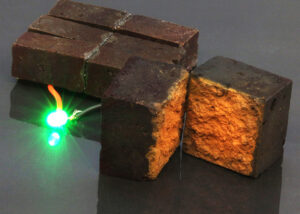Aug 12 2020
A new study by researchers at the Washington University in St. Louis reports that red bricks, some of the world’s most well-known and inexpensive building materials, can be transformed into energy storage units that can be charged to store electricity, similar to a battery.
 Chemists in Arts & Sciences have developed a method to make or modify “smart bricks” that can store energy until required for powering devices. Image Credit: D’Arcy laboratory.
Chemists in Arts & Sciences have developed a method to make or modify “smart bricks” that can store energy until required for powering devices. Image Credit: D’Arcy laboratory.
Over thousands of years, brick has been used to construct walls and buildings, but it is hardly fit for any other use. At present, chemists in Arts & Sciences have formulated a technique to make or modify “smart bricks” that can hold energy until it is needed for powering devices. A proof-of-concept reported in the Nature Communications journal on August 11th, 2020, depicts a brick directly powering a green LED light.
Our method works with regular brick or recycled bricks, and we can make our own bricks as well. As a matter of fact, the work that we have published in Nature Communications stems from bricks that we bought at Home Depot right here in Brentwood (Missouri); each brick was 65 cents.
Julio D’Arcy, Assistant Professor of Chemistry, Washington University in St. Louis
Walls and buildings constructed with bricks occupy huge space, which could be used in a better way if an extra purpose of electrical storage is added. Certain designers and architects have already identified the potential of the humble brick to harness and store the sun’s heat, but this is the first time scientists have attempted to use bricks for anything other than a thermal mass for cooling and heating.
D’Arcy and his collaborators, including graduate student Hongmin Wang at the Washington University, who is the first author of the new study, demonstrated how red bricks can be transformed into a kind of energy storage device known as a supercapacitor.
In this work, we have developed a coating of the conducting polymer PEDOT, which is comprised of nanofibers that penetrate the inner porous network of a brick; a polymer coating remains trapped in a brick and serves as an ion sponge that stores and conducts electricity.
Julio D’Arcy, Assistant Professor of Chemistry, Washington University in St. Louis
Iron oxide or rust, which is the red pigment present in bricks, is vital for initiating the polymerization reaction. The calculations of the researchers indicate that walls made of such energy-storing bricks could hold a significant amount of energy.
PEDOT-coated bricks are ideal building blocks that can provide power to emergency lighting. We envision that this could be a reality when you connect our bricks with solar cells —this could take 50 bricks in close proximity to the load. These 50 bricks would enable powering emergency lighting for five hours.
Julio D’Arcy, Assistant Professor of Chemistry, Washington University in St. Louis
Arcy added, “Advantageously, a brick wall serving as a supercapacitor can be recharged hundreds of thousands of times within an hour. If you connect a couple of bricks, microelectronics sensors would be easily powered.”
Journal Reference
Wang, H., et al. (2020) Energy storing bricks for stationary PEDOT supercapacitors. Nature Communications. doi.org/10.1038/s41467-020-17708-1.